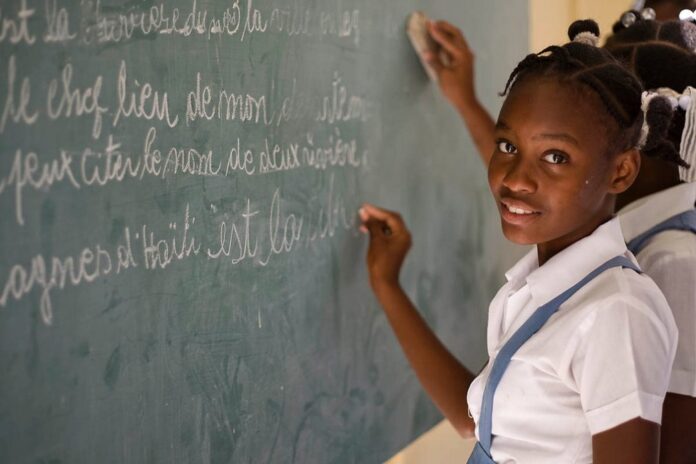“Educating girls is not just the right thing to do, it’s also the smart thing to do.” – Barack Obama
“Girls’ education is the single most effective way to combat poverty, reduce infant mortality, and improve economic prospects.” – Nicholas Kristof
In this article you will learn
- What is Girls’ Education
- Why you need to educate girls’ child
- Facts and figures about girls’ child education
- The Challenges of girls’ child education
- The advantages of girls’ child education
- The history of girls’ child education in Nigeria
- The progress so far
Girls’ education refers to the provision of learning opportunities specifically tailored to meet the needs and empower the potential of female students. It encompasses academic, social, and personal development, aiming to ensure that girls have equal access to quality education, enabling them to reach their full potential and contribute positively to society.
Education offers girls the necessary skills and information needed to excel in a chosen career in future Hence, a girl who is educated can grow to become a teacher, architect, doctor, computer scientist, lawyer and pharmacist, among other lucrative and noble professions. And by giving girls a right to education we can be able to right the wrongs in our society.
Girls of today are the women of tomorrow. To achieve true women empowerment it is important, to begin with, a girl child. As aware citizens, we all must encourage society to work for women’s empowerment and stop female infanticide.
The mindset that a girl is a liability must be changed at the grass-root level and spreading awareness is a must. In this, the role of education is important here and goes a long way in empowering women. More and more girls must be sent to school and provided with quality education, healthy food, equality, freedom of choice, and holistic education.
Educated girls can make the right decision in life and if in society both the genders are well educated we will see a decreased level of poverty, and more participation of women in socio-economic processes for better growth and development. If a woman is educated the entire generation gets benefits.
Girls’ education is like sowing the seed which gives rise to a revitalized, cheerful and full grown family plant.
Girls’ education goes beyond getting girls into school. It is also about ensuring that girls learn and feel safe while in school; have the opportunity to complete all levels of education, acquiring the knowledge and skills to compete in the labor market; gain socio-emotional and life skills necessary to navigate and adapt to a changing world; make decisions about their own lives; and contribute to their communities and the world.
Investing in girls’ education transforms communities, countries and the entire world. Girls who receive an education are less likely to marry young and more likely to lead healthy, productive lives. They earn higher incomes, participate in the decisions that most affect them, and build better futures for themselves and their families.
Girls’ education strengthens economies and reduces inequality. It contributes to more stable, resilient societies that give all individuals – including boys and men – the opportunity to fulfill their potential.
Here are some facts and figures about girls’ education:
Global Statistics:
132 million girls aged 6-17 are out of school, with 34 million at primary level and 98 million at secondary level. (UNESCO, 2020)
Girls are 2.5 times more likely to be out of school than boys in conflict-affected countries. (UNICEF, 2020)
1 in 5 girls worldwide are denied an education due to poverty, violence, or discrimination. (Malala Fund, 2020)
Every additional year of schooling can increase a girl’s earning potential by 10-20%. (World Bank, 2018)
Educated girls are 3 times more likely to invest in their children’s education. (UNICEF, 2019)
Regional Disparities:
Sub-Saharan Africa: 34% of girls are out of school, compared to 24% of boys. (UNESCO, 2020)
South Asia: 16% of girls are out of school, compared to 10% of boys. (UNESCO, 2020)
Middle East and North Africa: 13% of girls are out of school, compared to 8% of boys. (UNESCO, 2020)
The Challenges to Girls’ Child Education
Access to Education: 122 million girls worldwide are out of school, including 34 million of primary school age and 87 million of secondary school age.
Completion Rates: Girls’ completion rates lag behind boys’, especially in low-income countries, where 63% of girls complete primary school compared to 67% of boys.
Learning Poverty: 50% of females and 56% of males in low- and middle-income countries cannot read proficiently at age 10.
Gender Bias: Stereotypes within schools and classrooms affect girls’ ambitions, academic performance, and career choices, particularly in STEM fields.
Poverty: Girls from low-income families, remote areas, or minority groups face significant barriers to accessing and completing education.
Violence: Approximately 60 million girls experience sexual assault on their way to or at school each year, leading to lower attendance and higher dropout rates.
Child Marriage and Pregnancy: Girls who marry young or become pregnant often drop out of school, face stigma and discrimination, and have limited future opportunities.
10 advantages of educating a girl child:
- Economic Empowerment: Educated girls secure better-paying jobs, leading to financial independence and economic growth.
- Improved Health Outcomes: Educated girls make informed decisions about health, nutrition, and family planning.
- Reduced Poverty: Education breaks the cycle of poverty, uplifting entire families and communities.
- Social Change: Educated girls advocate for their rights and others’, driving social and political change.
- Better Child Education: Educated mothers prioritize and invest in their children’s education.
- Confidence and Empowerment: Education enhances self-esteem, enabling girls to make informed decisions.
- Increased Job Opportunities: Education opens doors to various career paths and professional success.
- Improved Life Quality: Educated girls lead healthier, more fulfilling lives and preserve their individuality.
- Role Modeling: Educated girls inspire younger generations as role models.
- Multiplier Effect: Educating a girl benefits her family, community, and society as a whole.
The History of Girls’ Child Education in Nigeria:
Early Years (Pre-1920)
In Nigeria, primary and secondary education was initially provided by voluntary Christian organizations. By 1920, only three out of 25 secondary schools were exclusively for girls, while the remainder catered to boys.
Colonial Era (1920-1950s)
The colonial government began providing subsidies to voluntary associations involved in education in 1920. By 1949, only eight out of 57 secondary schools were girls-only institutions. Notable girls’ schools established during this period include:
- Methodist Girls’ High School, Lagos (1879)
- St. Anne’s School, Molete, Ibadan (1896)
- Queens College, Lagos (1927)
- St. Theresa’s College, Ibadan (1932)
- Holy Rosary College, Enugu (1935)
- Anglican Girls Grammar School, Lagos (1945)
- Queen Amina College and Alhuda College, Kano
Post-Colonial Era (1950s-1960s)
Between 1950 and 1960, six more notable girls’ schools were established, bringing the total to 14. However, boys-only schools still outnumbered girls’ schools, with 61 institutions.
UN Intervention and Universal Primary Education (1960s-1970s)
In 1961, the United Nations announced its Universal Declaration of Human Rights and UNESCO’s educational plans for Nigeria. The goal was to achieve 100% universal primary education by 1980. The Nigerian government implemented the free and compulsory Universal Primary Education (UPE) program in the 1970s.
Increased Enrollment and Awareness (1970s-1990s)
Although traditional philosophies initially limited girls’ access to education, government intervention and public awareness campaigns led to increased enrollment. By the 1990s, purposeful plans of action resulted in more females attending school. The gap between boys’ and girls’ enrollment narrowed from 138,000 in 1991 to 69,400 in 1998.
Pan-African Conference and Reforms (1993)
At the 1993 Ouagadougou Conference, Nigeria was identified as lagging behind other regions in female access to education. The conference highlighted the need to eliminate policies hindering girls’ full participation in education.
Progress in Girls’ Child Education
Global enrollment rates for girls increased from 78% to 85% between 2000 and 2019. (UNESCO, 2020)
15 countries have achieved gender parity in education since 2000. (UNESCO, 2020)
International aid for girls’ education increased by 20% between 2015 and 2019. (Global Partnership for Education, 2020)
In conclusion
Educating a girl child is crucial for her overall development, empowering her to reach her full potential. It:
- Removes ignorance and darkness
- Ensures better health for future generations
- Reduces child mobility and mortality
- Triggers achievement of sustainable development goals
- Prepares her for societal realities
- Enables self-discovery and independence
Education is a fundamental human right, essential for every girl child, regardless of age or nationality. It unlocks her abilities, character, and mind, transforming her into a capable individual, wife, mother, and contributor to society.





























Informative